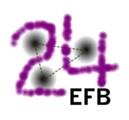Speaker
Description
Since the origin of nuclear physics, cluster structures have been observed in the excited states of many light nuclei.${}^\text{1}$ It is noted that $\alpha$ particles are strong cluster candidates due to their significant binding energy and energy of their first excited state. Evidence for this clustering lies within the energy levels of the compound nucleus formed in scattering reactions, which correspond to resonances in the reaction cross section.
In a commissioning experiment in collaboration with Texas A&M University, the thick target inverse kinematics (TTIK) method has been used to perform continuous measurement of the elastic scattering excitation function of the $^{14}\text{O}$ nucleus. Excited states above the $\alpha$ threshold have been populated using the ${}^4\text{He}({}^{10}\text{C},\alpha){}^{10}\text{C}$ reaction with a radioactive ${}^{10}\text{C}$ beam. A Micromegas gaseous parallel plate detector was used to facilitate high resolution track reconstruction, and silicon strip detector (SSD) arrays employed to reconstruct the energies of the scattered particles.
The current state of the analysis will be presented, starting from track identification via an iterative implementation of the Hough Transformation.
References
- A. Di Pietro et al., "The Inverse Kinematics Thick Target scattering method as a tool to study cluster states in exotic nuclei," Journal of Physics: Conference Series 366, 12013 (2012).
